Excerpts from Jim Conrad's
Naturalist Newsletter
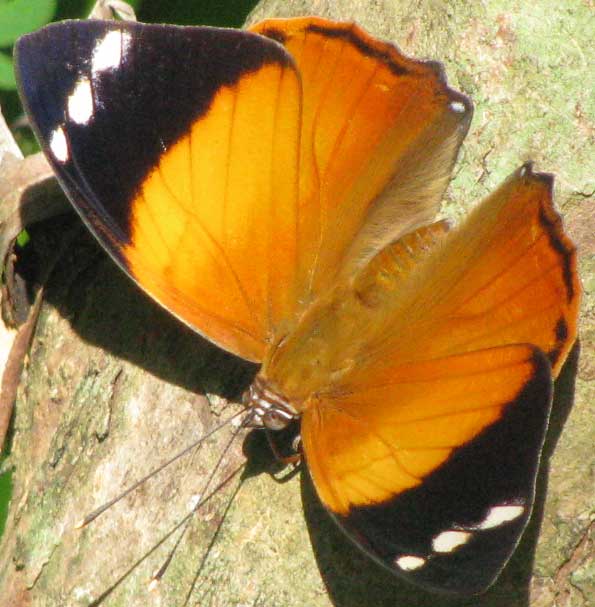
from the June 20, 2010 Newsletter issued from Hacienda Chichen Resort beside Chichén Itzá Ruins, central Yucatán, MÉXICO; limestone bedrock, elevation ~39m (~128ft), ~N20.676°, ~W88.569°
BLOMFILD'S BEAUTY BUTTERFLY
I've been here for seven months and during that time I don't believe I ever saw the pretty butterfly shown above. A side view showing a much different pattern is seen below:
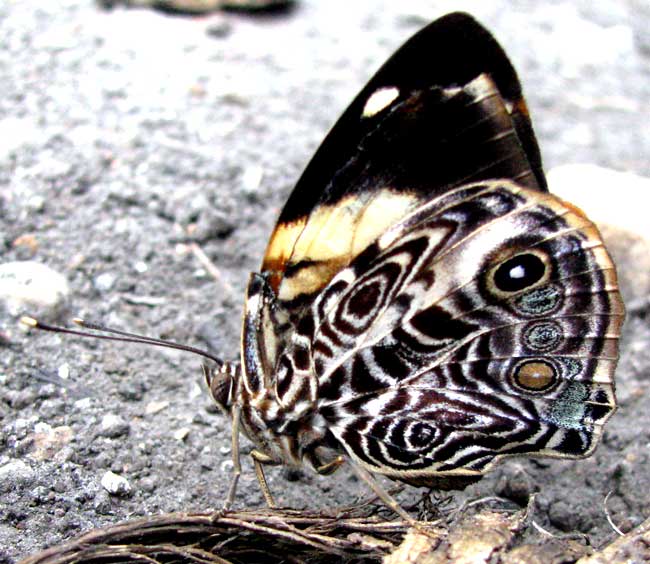
Noticing how big-headed, thick-bodied butterfly avoided holding its wings completely horizontally, I thought that maybe it was an unusually colorful skipper. However, Bea in Ontario pointed out that the antennae aren't hooked like those of skippers she's seen, so she didn't even bother looking among the skippers.
It's a male Blomfild's Beauty, SMYRNA BLOMFILDIA, a member of the huge Brush-footed Butterfly Family, the Nymphalidae, closely related to the North's Admirals. The species feeds on Urera trees, stinging members of the Nettle Family, and we have lots of Ureras here, which we called Cow-Itch. We look at them at www.backyardnature.net/yucatan/cow-itch.htm.
Adult Blomfild's Beauties feed on rotting fruit, which explains why they can't stay away from the mango peels on my compost heap. The species is distributed from Peru through Central America and Mexico, wandering periodically into southern Texas where butterfly watchers regard it as a great sighting
from the November 28, 2010 Newsletter issued from Hacienda Chichen Resort beside Chichén Itzá Ruins, central Yucatán, MÉXICO; limestone bedrock, elevation ~39m (~128ft), ~N20.676°, ~W88.569°
PUPA ON A ROCK
Two weeks ago Santos came to my door and said, "There's something on this rock you might like to see." He'd been gathering limestone rocks to build a traditional elevated clothes-washing sink, or batea, behind my hut. You can see Santos's inch-long (25mm) item stuck to the backside of the basketball-size rock below:
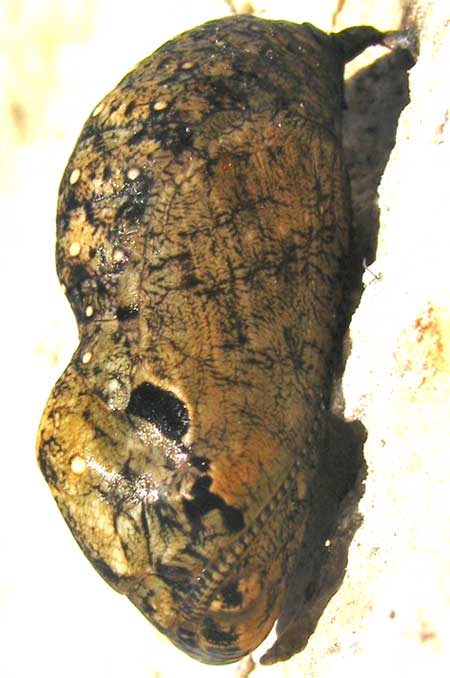
It's the pupa, or resting stage, of a lepidopterous insect -- the third step in the four-step complete metamorphosis of a butterfly or moth. Remember:
egg --> larva --> pupa --> adult
In the above picture, on the pupa's right side you can see the pattern of wings developing just below the pupa's husk. On the right side there are low, rounded ridges indicating the future adult's segmented abdomen. At the pupa's bottom, notice the diagonal, zipper-like design.
I shipped the picture to Bea in Ontario, suggesting that the zipper design was an artifact of the feathery antenna of the adult developing inside. Since butterflies have simple, hairlike antennae and moths have feathery ones, I guessed that a moth was developing inside. She wrote back:
"Most moths spin a cocoon or go underground to pupate and their pupae are usually just plain rusty brown with no markings."
So, she thought that this was a butterfly pupa, in which case the special name for the pupa would be "chrysalis." We'd say that we had a chrysalis stuck to a rock. Bea wondered if the zipper-like marking might not represent the fracture line along which the pupal husk eventually would split, and where the adult would emerge. Maybe the zippery line really was like a zipper.
All we could do was wait. I placed the rock next to my door and resolved to look at it each time I passed. About a week later, this Tuesday, I found what's shown below:
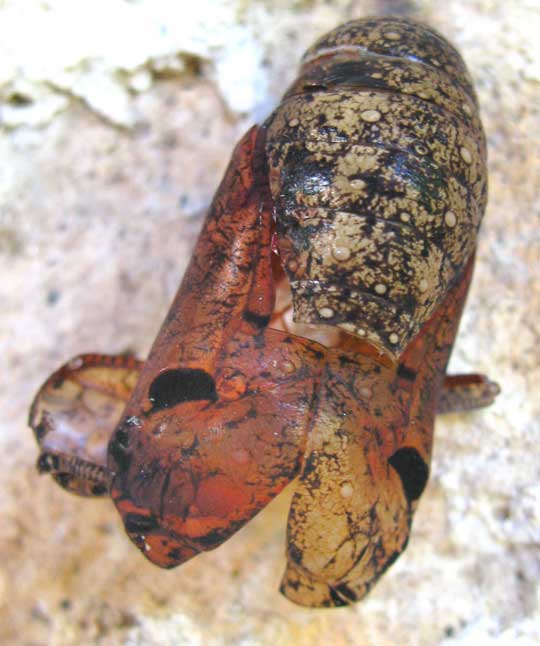
The adult had emerged and left, and it looks like Bea was right about its being a butterfly chrysalis, with the husk fracturing along the zippery lines, as shown below:
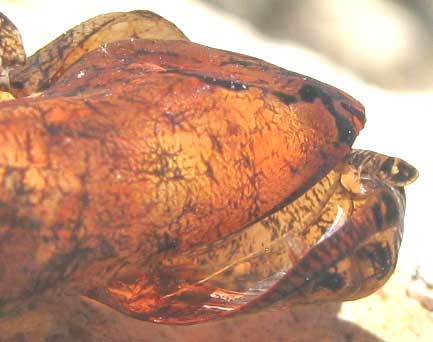
I was disappointed that the adult had gotten away, until I saw exactly what you can see next:
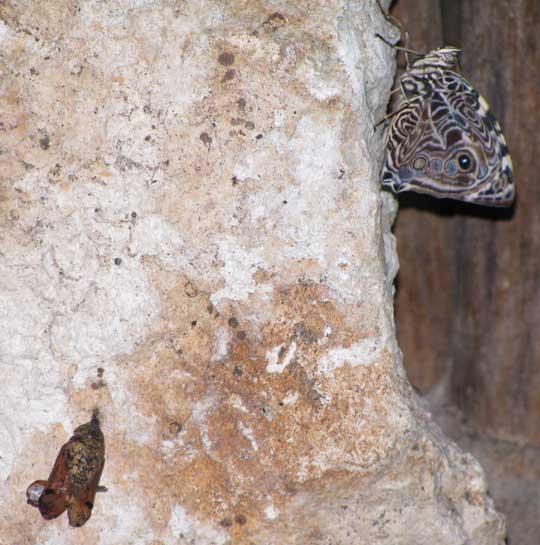
The split chrysalis lies at the lower left while the adult rests at the top, right, drying and stiffening its wings. The beautiful wing patterns are shown close up below:
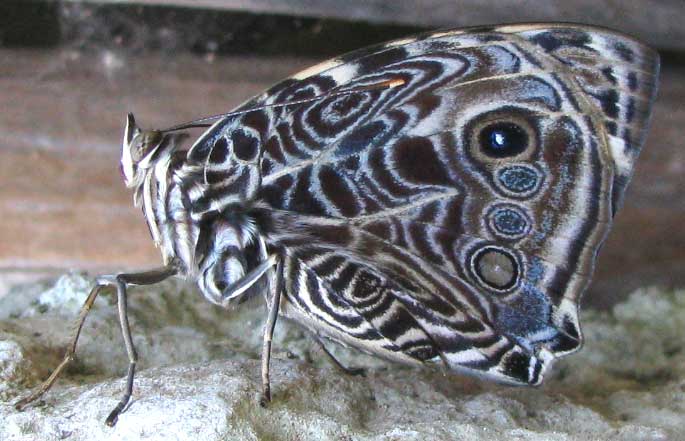
When I got too close to the adult the wings briefly spread, enabling me to glimpse the wings' upper pattern and colors, and know what species we had: The Blomfild's Beauty. It was a female of this sexually dimorphic species.